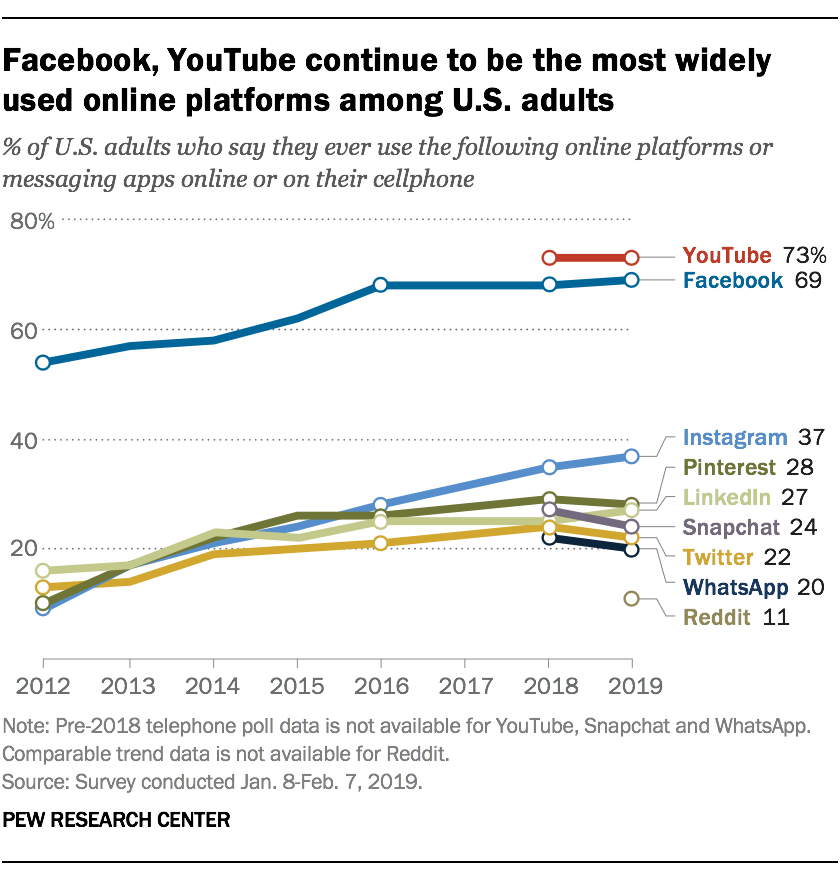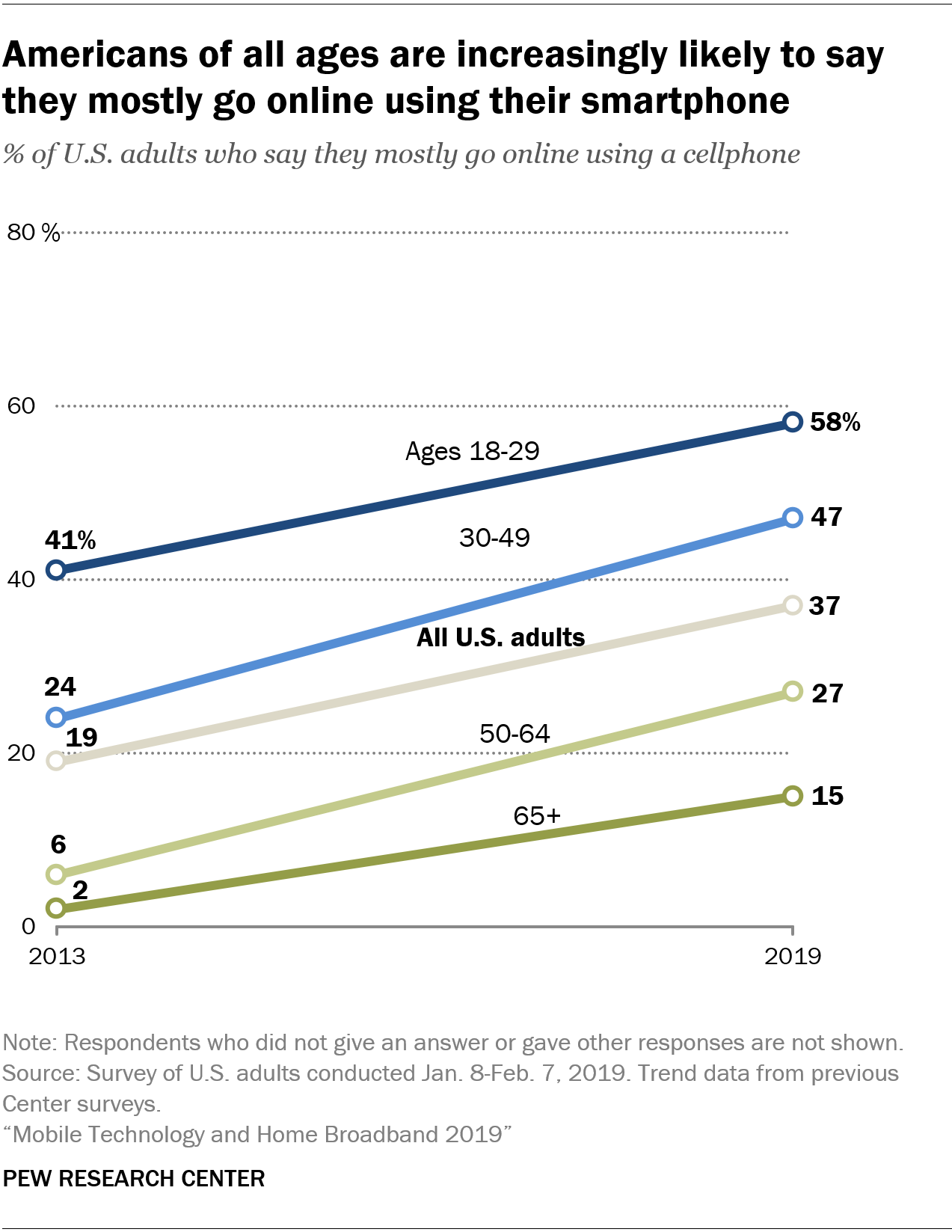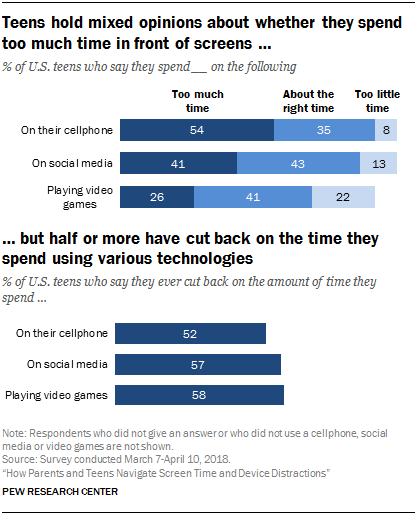Technology, it seems, moves with the speed of a lightning strike. Never has the evolution of technology so affected businesses of all sizes like it has done in the last several years. Recent research compiled by the Pew Research Center highlights just how tech trends over last decade have altered everything from daily communication to human interaction to how people conduct business. Here is a sampling of Pew’s findings and how it is already affecting you and your company whether you feel these trends or not.
-
Social media sites have emerged as a go-to platform for connecting with others, finding news and engaging politically. When the Center first asked U.S. adults if they ever use a social media site in 2005, just 5% said they did. Today, the share is 72%, according to a survey in early 2019.
Social media has also taken hold around the world. The Center’s spring 2017 global survey – conducted in 17 advanced and 19 emerging economies – found that a median of 53% of adults across emerging and developing countries use social media.
In the U.S. and around the world, younger adults are the most likely age group to use social media. For example, nine-in-ten Americans ages 18 to 29 report ever using a social media site, compared with 40% of those ages 65 and older.
In terms of specific platforms, YouTube and Facebook are the most widely used online platforms among U.S. adults, with roughly seven-in-ten Americans saying they use each site. The shares of adults who use Instagram and Snapchat are much smaller, but these platforms are especially popular with younger Americans.
- Smartphones have altered the way many Americans go online. One of the biggest digital trends of the decade has been the steady rise of mobile connectivity. Smartphone adoption has more than doubled since the Center began surveying on this topic in 2011.
Then, 35% of U.S. adults reported owning a smartphone of some kind, a share that has risen to 81% today.Teens have also become much more likely to use smartphones: More than nine-in-ten (95%) teens ages 13 to 17 report owning or having access to a smartphone, according to a 2018 survey.Adults are increasingly likely to name their smartphone as the primary way of going online. Today, 37% of U.S. adults say they mostly use a smartphone to access the internet, up from 19% in 2013.The 2010s, meanwhile, were also the decade that saw the advent of tablet computers, which are now used by around half (52%) of U.S. adults.
- Made-up news and misinformation has sparked growing concern. The lead-up to the 2016 U.S. presidential election brought to the surface concerns around misinformation and its ability to affect the democratic process. Half of Americans believe made-up news and misinformation is a very big problem for the country today, making it a pressing problem for more Americans than said so of terrorism, illegal immigration, sexism and racism, according to a 2019 survey. Some 68% of U.S. adults say made-up news greatly impacts Americans’ confidence in government institutions.The challenge of navigating the new information environment was reflected in a 2018 survey that measured the public’s ability to identify five factual statements and five opinion statements. A small share of Americans were able to correctly classify all 10 statements. About a third (35%) were able to correctly identify all five opinion statements, while around a quarter (26%) were able to correctly identify all five factual statements. Americans with high political awareness, those who are very digitally savvy and those who have high levels of trust in the news media were able to more accurately identify news-related statements as factual or opinion.
- Growth in mobile and social media use has sparked debates about the impact of screen time on America’s youth – and others. More than half of teens (54%) believe they spend too much time on their cellphone, while 41% say they spend too much time on social media and about one-quarter say the same about video games, a 2018 survey found.
At the same time, about half or more of teens say they have cut back on the amount of time they spend on their cellphones (52%), and similar shares say they have tried to limit their use of social media (57%) and video games (58%).Still, teens are not the only group who struggle with balancing their use of digital technology with other aspects of their lives. Some 36% of parents of teens say they themselves spend too much time on their cellphone, while a similar share (39%) say they at least sometimes lose focus at work because they’re checking their cellphone.
-Written by Kevin Sawyer


 Social media has also taken hold around the world. The Center’s spring 2017 global survey – conducted in 17 advanced and 19 emerging economies – found that a median of 53% of adults across emerging and developing countries use social media.
Social media has also taken hold around the world. The Center’s spring 2017 global survey – conducted in 17 advanced and 19 emerging economies – found that a median of 53% of adults across emerging and developing countries use social media. Then, 35% of U.S. adults reported owning a smartphone of some kind, a share that has risen to 81% today.Teens have also become much more likely to use smartphones: More than nine-in-ten (95%) teens ages 13 to 17 report owning or having access to a smartphone, according to a 2018 survey.Adults are increasingly likely to name their smartphone as the primary way of going online. Today, 37% of U.S. adults say they mostly use a smartphone to access the internet, up from 19% in 2013.The 2010s, meanwhile, were also the decade that saw the advent of tablet computers, which are now used by around half (52%) of U.S. adults.
Then, 35% of U.S. adults reported owning a smartphone of some kind, a share that has risen to 81% today.Teens have also become much more likely to use smartphones: More than nine-in-ten (95%) teens ages 13 to 17 report owning or having access to a smartphone, according to a 2018 survey.Adults are increasingly likely to name their smartphone as the primary way of going online. Today, 37% of U.S. adults say they mostly use a smartphone to access the internet, up from 19% in 2013.The 2010s, meanwhile, were also the decade that saw the advent of tablet computers, which are now used by around half (52%) of U.S. adults.
